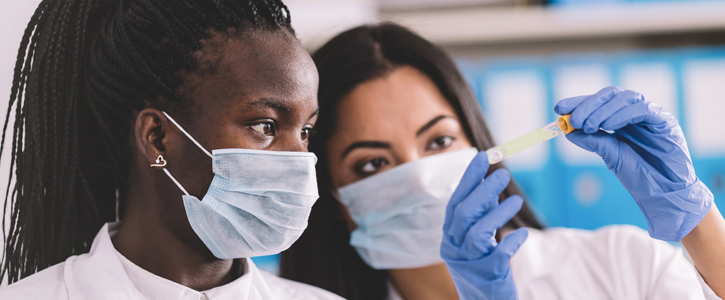
The BETA Center now hosts the Biomedical Engineering Summer Internship Program (BESIP) summer program under the guidance of Dr. Robert Lutz, BESIP Program Director. Engineering and science students interested in biomedical engineering research will come to the NIH campus for 10 weeks of an intensive in-person research experience allowing students to participate in cutting-edge biomedical research projects under the mentorship of world-class scientists and engineers in NIH labs. Potential projects for BESIP interns in 2024 are listed below. Central to BETA Center’s mission is employing evidence-driven approaches to expand diversity, equity, and inclusion within NIBIB’s Intramural Research Program and recruiting diverse biomedical engineering and imaging talent to NIH.
Design and build an improved time-of-flight PET photodetector device
Use of MRI for Quantitative Imaging and Tissue Sciences
Implementing FIND-Seq to understand HIV reservoirs
Exoskeleton-Mediated Gait Training in Children
Use of the Atomic Force Microscope (AFM) and mathematical modeling to understand the mechanobiology of cells and tissues
EEG Neurofeedback activation of electrical stimulation assistance during motor attempts to train ankle control in children and young adults with cerebral palsy
Balance and Gait Assessment of Individuals with CLN3 Disease
Biofabrication of engineered 3D tissues for disease modeling and drug discovery
The molecular and cellular effects of Therapeutic and Focused Ultrasound on tissue microenvironment
Augmented Reality Interactive Enhancements for Scientific Data Visualization and Manipulation
Exploring the Neural Mechanisms of Social Interaction: Unveiling New Insights through Virtual Reality, Eye Tracking, and fNIRS
Advanced control of radiofrequency hardware for MRI
Microfluidic device to monitor cellular proteostasis in rodent serum
Optimization of Prolonged Normothermic Ex Vivo Animation of Human Tumor-bearing Liver Segments
Engineering Novel Fluorescent Probes and Sensors for Studying G-Protein Coupled Receptors Involved in Addictive Disorders
Synthesis of Pharmacological Activity of Selective PY2 Receptor Antagonists
Atomic Force Microscopy and Structure of Plasmodium falciparum Circumsporozoite Protein and Lipid Rafts
Large-Scale Data Integration to Identify Signaling Pathways in Water-Balance Disorders
Ultrafast laser microscopy to study proteins and DNA. Fluorescent Lifetime Imaging: Approaches and Applications
Characterizing Spontaneous Movements During Early Development of Mice
Multiphoton microscopy of genetically-encoded reporters of biochemical signals in astrocytes
Evaluating chondrogenesis in a dish using engineered 3D microtissues
Nature or Nurture? Differences in brain white matter structure and architecture in twins using a novel diffusion MRI technique to assess brain morphometry
Improving pre-surgical planning of focused–ultrasound therapy for essential tremor using diffusion Magnetic Resonance Imaging (MRI)
Magnetic Resonance Angiography to Assess Sickle Cell Disease Mediated Carotid and Cerebral Artery Damage
Systems Biology and Protease Networks in Tissue Destructive Diseases
In vivo Mouse Cardiac Electrophysiology Recording System
Microfabricated PDMS Vessel Mimetics for Cancer Cell Culture
Role of innate immunity in medical device implantation and regenerative therapeutics
The utility of infrared imaging in assessing autoimmune disease
Deciphering the mechanism of macromolecular formation of non-muscle myosin-2 filaments using scattering and fluorescence single molecule techniques
Video Monitoring System for Automated Detection of Pain- and Itch- Related Behaviors in Mice
MRI Biomarkers of the Pelvis for Opportunistic Screening
Imaging Biomarkers for Diabetes Medications
Quantitative imaging and pooled CRISPRi screening of single cells to understand transcription factor signaling dynamics
Measure the viscoelastic properties of zerbafish brain using frequency optical tweezers to understand how the micro -mechanical properties of tissue affect metastatic tumor outgrowth
Production of hematopoietic cells from bone marrow endothelial cells
Development of point-of-care, biomedical optics technologies to non-invasively characterize tissue hemodynamics
New Technology for Time-Resolved NMR and for High-Resolution MRI at Low Temperatures
Developing an improved transurethral resection (TUR) device for bladder tumors
Characterization of immunotherapy-loaded drug-eluting microspheres and gels for transarterial embolization of liver tumors
Applying artificial intelligence in medical imaging
Development of a Non-Invasive Sweat Sensor for Detecting Traumatic Brain Injury Biomarkers in NCAA Football Players
Engineering approaches involving computational and signal to develop insights into the neural code of the human brain

